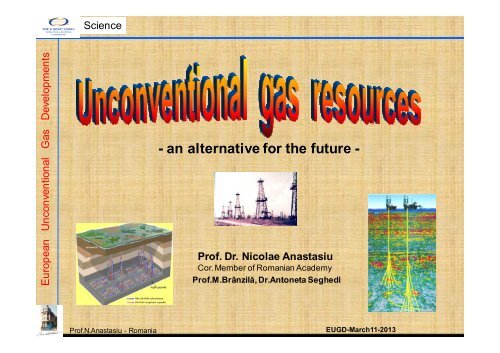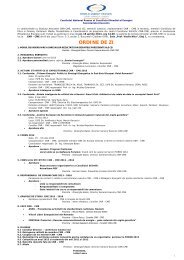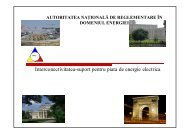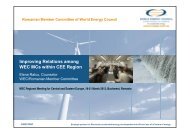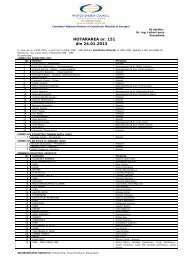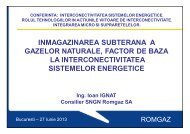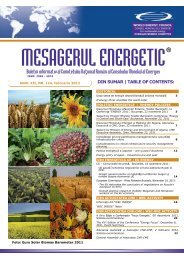Session 2 - Nicolae Anastasiu.pdf - Cnr -cme
Session 2 - Nicolae Anastasiu.pdf - Cnr -cme
Session 2 - Nicolae Anastasiu.pdf - Cnr -cme
Create successful ePaper yourself
Turn your PDF publications into a flip-book with our unique Google optimized e-Paper software.
Science<br />
European Unconventional Gas Developments<br />
- an alternative for the future -<br />
Prof. Dr. <strong>Nicolae</strong> <strong>Anastasiu</strong><br />
Cor. Member of Romanian Academy<br />
Prof.M.Brânzilă, Dr.Antoneta Seghedi<br />
Prof.N.<strong>Anastasiu</strong> - Romania<br />
EUGD-March11-2013
Science<br />
European Unconventional Gas Developments<br />
• Introduction<br />
Contents<br />
1.Types of Unconventional<br />
Resources<br />
2. Investigation methods<br />
3. Unconventional Gas Descriptioninternational<br />
standard<br />
4. Case Studies – Eastern Europe<br />
5. Gas Shales features – the<br />
Carpathians and Foreland<br />
• Conclusions<br />
Prof.N.<strong>Anastasiu</strong> - Romania<br />
EUGD-March11-2013<br />
2
Introd<br />
1.UR.<br />
Types<br />
2.<br />
Methode<br />
3.UG-<br />
Descrip<br />
4. Case-<br />
EastEur<br />
5. Romania Conclusion-<br />
European Unconventional Gas Developments<br />
Conventional plays<br />
Accumulations in medium to highly<br />
porous reservoirs with sufficient<br />
permeability to allow gas to flow to<br />
Well bore<br />
Vertical or horizontal completions<br />
Production from formation matrix,<br />
natural flow<br />
Production rates depend on<br />
permeability and porosity and<br />
estimated ultimate recoveries<br />
Unconventional plays<br />
Deposits of natural gas found in<br />
relatively impermeable rock formations<br />
(tight sands, shale and coal beds)<br />
Key technologies are horizontal drilling<br />
and modern hydraulic fracturing<br />
Production from natural and induced<br />
fractures (e.g shales are the source<br />
rock)<br />
Total organic carbon (TOC), thermal<br />
maturity and mineralogy determine<br />
reservoir and ultimate completion<br />
Development plans on a field basis<br />
Development plans on a well by well<br />
Prof.N.<strong>Anastasiu</strong> - Romania<br />
EUGD-March11-2013<br />
3
•The petroleum system – from conventional to unconventional<br />
Why, an unconventional resource?<br />
European Unconventional Gas Developments<br />
Reservoir conv.<br />
permeable<br />
Conventional<br />
Source rock<br />
oil<br />
water<br />
bioGas<br />
Conclusion<br />
-SWOT<br />
Bio-gas=conv<br />
Thermo-gas=unconv<br />
Unconventional – shale gas<br />
Aquifer – 150 m<br />
Shale thermo-gas - 3000 m<br />
reservoir impermeable<br />
Prof.N.<strong>Anastasiu</strong> - Romania<br />
EUGD-March11-2013<br />
4
Unconventional resources<br />
European Unconventional Gas Developments<br />
Production in 2010 was 283 billion cubic feet per day<br />
1.<br />
1.Oil sands – No<br />
2.Gas shales – Shale gas<br />
3.Tight gas inTight sand – compact formations<br />
(or secondary recovery)<br />
4.Coal Bed Methane<br />
5. Methane hydrate (in sea sediments)<br />
2.<br />
Prof.N.<strong>Anastasiu</strong> - Romania<br />
EUGD-March11-2013<br />
5
Introd<br />
1.UR.Ty<br />
Types<br />
2.<br />
Methode<br />
3.UG-<br />
Descrip<br />
4. Case-<br />
EastEur<br />
5. Romania Conclusions<br />
European Unconventional Gas Developments<br />
Reserves-Tcm<br />
35<br />
30<br />
25<br />
20<br />
15<br />
10<br />
5<br />
0<br />
24<br />
Shale Gas in place, by Rogner (AWR) - 2009<br />
11<br />
27,2 8,8 11,6 12,5 (364,9)<br />
U.S.A. Canada Europe China Implied rest of<br />
world<br />
9<br />
19<br />
34<br />
Tight<br />
CBM<br />
Shale Mean of estimate<br />
Prof.N.<strong>Anastasiu</strong> - Romania<br />
EUGD-March11-2013<br />
6
Introd<br />
1.UR.Ty<br />
Types<br />
2.<br />
Methods<br />
3.UG-<br />
Descrip<br />
4. Case-<br />
EastEur<br />
5. Romania Conclusions<br />
European Unconventional Gas Developments<br />
Oil sands (bituminous sands)<br />
Location : Canada, Kazakhstan, Rusia, Madagascar, SUA;<br />
Fort McMurray = 3 400 km 2<br />
Reserves: Canada, Alberta: 177 Md barili,<br />
Status: semisolide, viscosity is high (10 000 centipoise) = extra heavy oil<br />
Exploitation: open pit (quarry); or pit by hundred meters - green house effect<br />
.<br />
Production: in 2006 = 1,26 mil barili/zi (44% from total in Canada; 80 new<br />
Projects)<br />
Profit = 21,75 $/barili (conventional oil=12,41$/baril)<br />
Secondary recovery- heavy metals:<br />
vanadiu, nickel, plumb, zinc, cobalt, mercur, crom, cadmiu, seleniu, cupru, m<br />
angan.<br />
Prof.N.<strong>Anastasiu</strong> - Romania<br />
EUGD-March11-2013<br />
7
Introd<br />
1.UR.Ty<br />
Types<br />
2.<br />
Methods<br />
3.UG-<br />
Descrip<br />
4. Case-<br />
EastEur<br />
5. Romania Conclusions<br />
European Unconventional Gas Developments<br />
Exploitation in a Quarry<br />
McMurray Fm. - Oil sands Alberta<br />
Prof.N.<strong>Anastasiu</strong> - Romania<br />
EUGD-March11-2013<br />
8
Introd<br />
1.UR.Ty<br />
Types<br />
2.<br />
Methods<br />
3.UG-<br />
Descrip<br />
4. Case-<br />
EastEur<br />
5. Romania<br />
Conclusions<br />
European Unconventional Gas Developments<br />
...din faciesuri continentale<br />
Continental facies…..<br />
McMurray Fm. - Oil sands Alberta<br />
Photo: B.Varban<br />
Canale de bioturbaţie<br />
Burrows<br />
Laminaţii concoide<br />
Trough lamination<br />
Prof.N.<strong>Anastasiu</strong> - Romania<br />
Scurgeri de ţiţei –<br />
Oil flow - bitum<br />
EUGD-March11-2013<br />
9
Introd<br />
1.UR.Ty<br />
Types<br />
2.<br />
Methods<br />
3.UG-<br />
Descrip<br />
4. Case-<br />
EastEur<br />
5. Out-Wells<br />
Conclusion<br />
5. Romania Conclusions<br />
Data<br />
-SWOT<br />
McMurray Fm. - Oil sands Alberta<br />
European Unconventional Gas Developments<br />
Workers....and machineries<br />
Prof.N.<strong>Anastasiu</strong> - Romania<br />
EUGD-March11-2013<br />
10
Introd<br />
1.UR.Ty<br />
Types<br />
2.<br />
Methods<br />
3.UG-<br />
Descrip<br />
4. Case-<br />
EastEur<br />
5. Romania Conclusions<br />
European Unconventional Gas Developments<br />
Tight sands (and Tight gas ) very low permeability<br />
It is stuck in a very tight formation underground, trapped in unusually<br />
impermeable, hard rock, or in a sandstone or limestone formation that is<br />
unusually impermeable and non-porous.<br />
Location: many countries - USA, Canada, Rusia,Venezuela,Australia,<br />
Argentina, China, Egipt…..on hundred-thousand SqKm.<br />
Reserves: 100 000 x 10 9 m 3 , in SUA- 1600 reservoires, 900 gas filelds.<br />
Status: very low permeability (1 nanodarcy), and effective porosity - in<br />
sandstones, limestones.<br />
Depth, and burial: 3000-3500 m, versus conventional gas, la 1000-<br />
1500 m.<br />
Extraction: by secondary recovery, with horisontal drilling, and hydraulic<br />
fracturing.<br />
Production: in SUA, din 40000 wells = 2-3 Trilioane cf=0,8-1 Bil m 3 /y.<br />
Prof.N.<strong>Anastasiu</strong> - Romania<br />
EUGD-March11-2013<br />
11
Introd<br />
1.UR.Ty<br />
Types<br />
2.<br />
Methods<br />
3.UG-<br />
Descrip<br />
4. Case-<br />
EastEur<br />
5. Romania Conclusions<br />
European Unconventional Gas Developments<br />
Tight Sands<br />
50-100 m aquifer<br />
Tight gas<br />
3000 m<br />
CO 2<br />
We can solve green house effect!<br />
Secondary<br />
Recovery:<br />
De la 30…la 70%<br />
Prof.N.<strong>Anastasiu</strong> - Romania<br />
EUGD-March11-2013<br />
12
Introd<br />
1.UR.Ty<br />
Types<br />
2.<br />
Methods<br />
3.UG-<br />
Descrip<br />
4. Case-<br />
EastEur<br />
5. Romania Conclusions<br />
European Unconventional Gas Developments<br />
Coal Bed Methane (CBM)<br />
and<br />
Underground Coal Gasification-UCG/GTL-Fischer Tropsch gas to liquids<br />
Location in fossil coal areas , brown coal,<br />
Reserves: 7 500 Tcf, in the world, 700 Tcf in USA,<br />
Status: solid, close to shales, sandstones, tens of meters thickness.<br />
Depth: hundred m. to 1500 m.<br />
Extraction : can be extracted and injected into natural gas pipelines<br />
for resale.<br />
Production: 8 500 m 3 /day: in 2010 USA – 1886 -BCF<br />
Prof.N.<strong>Anastasiu</strong> - Romania<br />
EUGD-March11-2013<br />
2
Introd<br />
1.UR.Ty<br />
Types<br />
2.<br />
Methods<br />
3.UG-<br />
Descrip<br />
4. Case-<br />
EastEur<br />
5. Romania Conclusions<br />
European Unconventional Gas Developments<br />
CBM<br />
1500 m<br />
UCG/GTL<br />
100-200m<br />
Brown coal<br />
Higher rank of coal<br />
Prof.N.<strong>Anastasiu</strong> - Romania<br />
EUGD-March11-2013<br />
Lignite<br />
lowest rank of coal<br />
15
Introd<br />
1.UR.Ty<br />
Types<br />
2.<br />
Methods<br />
3.UG-<br />
Descrip<br />
4. Case-<br />
EastEur<br />
5. Romania Conclusions<br />
European Unconventional Gas Developments<br />
Methane hydrate (gaz hidrati)<br />
These interesting formations are made up of a lattice of frozen<br />
water, which forms a sort of 'cage' around molecules of methane.<br />
These hydrates look like melting snow.<br />
It is stable in ocean floor sediments at water depths greater than 300<br />
meters, and where it occurs, it is known to cement loose sediments in<br />
a surface layer several hundred meters thick. 2˚ C, P>30 atm.<br />
Methane hydrates may contain more organic carbon than the world's<br />
coal, oil, and conventional natural gas – combined =<br />
from 7,000 Tcf to over 73,000 Tcf.<br />
Prof.N.<strong>Anastasiu</strong> - Romania<br />
EUGD-March11-2013<br />
16
Introd<br />
1.UR.Ty<br />
Types<br />
2.<br />
Methods<br />
3.UG-<br />
Descrip<br />
4. Case-<br />
EastEur<br />
5. Romania Conclusions<br />
European Unconventional Gas Developments<br />
423.488 km².<br />
Prof.N.<strong>Anastasiu</strong> - Romania<br />
EUGD-March11-2013<br />
17
Introd<br />
1.UR.Ty<br />
Types<br />
2.<br />
Methods<br />
3.UG-<br />
Descrip<br />
4. Case-<br />
EastEur<br />
5. Romania Conclusions<br />
European Unconventional Gas Developments<br />
Last but not least….<br />
Gas shales to Shale gas<br />
Location: in 48 basins, 32 countries, with 70 de shale formations:<br />
USA, Canada, Rusia, Venezuela, Australia, Argentina, China,<br />
Egipt…..tens to hundred km 2 .<br />
Reserves: UE (2,4 Tcm), China (36 Tcm), USA (24,4 Tcm) and Mexico<br />
(10,9Tcm).<br />
Status: v.low permeability-10 nanodarcy, porosity is low, brittle rocks.<br />
Depth (burrial condition): 3000-3500 m, with slates, and black shales.<br />
Exploitation by drilling, and wells – horizontal, and hydraulic fracturing.<br />
Production: 11 Tcf (cca 4 Md m 3 -2020 in the world; in USA, 2010 –<br />
24% din total ; next 20 years….35%<br />
Prof.N.<strong>Anastasiu</strong> - Romania<br />
EUGD-March11-2013<br />
18
Introd<br />
1.UR.Ty<br />
Types<br />
2.<br />
Methods<br />
3.UG-<br />
Descrip<br />
4. Case-<br />
EastEur<br />
5. Romania Conclusions<br />
European Unconventional Gas Developments<br />
On production<br />
2011 - > 100 000 drills<br />
24%<br />
HP<br />
HP<br />
HP<br />
R<br />
Not yet<br />
HP<br />
High potential-HP<br />
International<br />
- interest<br />
HP<br />
Prof.N.<strong>Anastasiu</strong> - Romania<br />
EUGD-March11-2013<br />
19
Introd<br />
1.UR.Ty<br />
Types<br />
2.<br />
Methods<br />
3.UG-<br />
Descrip<br />
4. Case-<br />
EastEur<br />
5. Romania Conclusions<br />
European Unconventional Gas Developments<br />
S.U.A.<br />
Mexic<br />
China<br />
Pakistan<br />
Australia<br />
Africa de Sud<br />
Tunisia<br />
Maroc<br />
Venezuela<br />
Argentina<br />
Chile<br />
Paraguay<br />
Europa<br />
Germania<br />
Norvegia<br />
Danemarca<br />
Polonia<br />
Ucraina<br />
0 5000 10000 15000 20000 25000 30000 35000 40000<br />
509<br />
1783<br />
1444<br />
311<br />
0<br />
545<br />
1022<br />
50<br />
41<br />
317<br />
388<br />
232<br />
14<br />
0<br />
5096<br />
226<br />
481<br />
2350<br />
566<br />
651<br />
1160<br />
5294<br />
424<br />
1189<br />
6540<br />
8211<br />
10985<br />
11212<br />
Reserves - Bcm<br />
13732<br />
19281<br />
24406<br />
Source: EIA Report April 2011<br />
36100<br />
Source: EIA Report April 2011<br />
unconventional<br />
conventional<br />
Prof.N.<strong>Anastasiu</strong> - Romania<br />
EUGD-March11-2013<br />
20
Introd<br />
1.UR.Ty<br />
Types<br />
2.<br />
Methods<br />
3.UG-<br />
Descrip<br />
4. Case-<br />
EastEur<br />
5. Romania Conclusions<br />
European Unconventional Gas Developments<br />
Europe Geological Map – Romania location<br />
Romania<br />
Prof.N.<strong>Anastasiu</strong> - Romania<br />
EUGD-March11-2013<br />
22
European Unconventional Gas Developments<br />
Introd<br />
Franta<br />
Germania<br />
Olanda<br />
Norvegia<br />
Marea Britanie<br />
Danemarca<br />
Suedia<br />
Polonia<br />
Turcia<br />
Ucraina<br />
Lituania<br />
1.UR.Ty<br />
Types<br />
Reserves: Trmc<br />
-<br />
Geological Age<br />
mil.y<br />
France<br />
German<br />
y Holland UK Sweden Norway Poland Hungary<br />
Romani<br />
a<br />
Ucraine<br />
3,1 0,57 1,16 2,35 5,3 0,54 1,19<br />
Miocene 226<br />
12<br />
Cretaceous 80 Weald Clay<br />
481<br />
150 Alum Posidoni Posidon<br />
Jurasic<br />
Shale a Shale ia Shale<br />
Carbonifer<br />
Devonian<br />
Silurian<br />
Cambrian<br />
2.<br />
Methods<br />
Age of Gas Shales formations / Countries/Reserves<br />
320<br />
360<br />
420<br />
520<br />
3.UG-<br />
Descrip<br />
Shale<br />
Namuri<br />
an<br />
marine<br />
Shales<br />
4. Case-<br />
EastEur<br />
5. Romania Conclusions<br />
0 1000 2000 3000 4000 5000 6000<br />
113<br />
424<br />
566<br />
651<br />
1160<br />
1189<br />
2350<br />
Reserves – Bil (Md.)cm<br />
Devonia<br />
n shales<br />
Alum<br />
shale<br />
Bitumin<br />
ous<br />
Slate<br />
Mako<br />
5096<br />
Miocene<br />
shales<br />
Black<br />
5294<br />
shalesgraptolit<br />
Black<br />
es shales<br />
Shale Gas Fields in the Europe<br />
- red area<br />
Source: EIA Report April 2011<br />
Prof.N.<strong>Anastasiu</strong> - Romania<br />
Source: EIA Report<br />
EUGD-March11-2013<br />
April 2011<br />
24
Introd<br />
1.UR.Ty<br />
pes<br />
2.<br />
Methode<br />
3.UG-<br />
Descrip<br />
4. Case-<br />
EastEur<br />
5. Romania Conclusions<br />
European Unconventional Gas Developments<br />
Objectives and methods<br />
An example<br />
Investigation related to GS will be by outcrops records<br />
...and description,<br />
related to:<br />
1. Map location<br />
2.Topo of GPS position (Lat/Long/Elev)<br />
3. Facies descriptions<br />
4. Boundaries, extension<br />
5.Sampling – Analysis (XR,SEM,TOC<br />
etc)<br />
Prof.N.<strong>Anastasiu</strong> - Romania<br />
EUGD-March11-2013<br />
26
Introd<br />
1.UR.Ty<br />
pes<br />
2.<br />
Methods<br />
3.UG-<br />
Descrip<br />
4. Case-<br />
EastEur<br />
5. Romania Conclusions<br />
European Unconventional Gas Developments<br />
Investigation by Core and Well Log –records<br />
(to use in sequence analysis)<br />
Wells Logs<br />
…to have information on geometry bodies…depositional systems….systems tracts<br />
Prof.N.<strong>Anastasiu</strong> - Romania<br />
EUGD-March11-2013<br />
27
Introd<br />
1.UR.Ty<br />
pes<br />
2.<br />
Methods<br />
3.UG-<br />
Descrip<br />
4. Case-<br />
EastEur<br />
5. Romania Conclusions<br />
European Unconventional Gas Developments<br />
by Data Integration and Interpretation<br />
to provide the following:<br />
Rock-log calibration of open-hole logs for the development of<br />
petrophysical models to determine productive properties.<br />
Y<br />
Integrate the rock data with well logs, fracture stimulation techniques,<br />
and production test results.<br />
A<br />
L<br />
O<br />
N<br />
G<br />
W<br />
A<br />
Prof.N.<strong>Anastasiu</strong> - Romania<br />
EUGD-March11-2013<br />
28
Introd<br />
1.UR.Ty<br />
pes<br />
2.<br />
Methods<br />
3.UG-<br />
Descrip<br />
4. Case-<br />
EastEur<br />
5. Romania Conclusions<br />
European Unconventional Gas Developments<br />
Gas Shales –<br />
What means Gas Shales?<br />
“complexity of formations”<br />
What properties GS have – a condition for succes!<br />
Where we can find GS in Romania?<br />
- Geological units;<br />
- Geological age;<br />
- Potential Sedimentary Formations.<br />
A potential for shale gas are:<br />
Synonym= “șisturile bituminoase = bituminous<br />
slate”,<br />
= argilele bituminoase,<br />
= “argilele negre = black shale”<br />
= argilite (=slate) etc. și, alte petrotipuri<br />
generatoate de hidrocarburi :<br />
= bit.marls, limestones ?<br />
= “rocile sursă (=source rock)“ sau “rocile<br />
mamă“<br />
Prof.N.<strong>Anastasiu</strong> - Romania<br />
All with captiv natural gas.<br />
EUGD-March11-2013<br />
29
Introd<br />
1.UR.Ty<br />
pes<br />
2.<br />
Methods<br />
3.UG-<br />
Descrip<br />
4. Case-<br />
EastEur<br />
5. Romania Conclusions<br />
European Unconventional Gas Developments<br />
Gas shales – different facies<br />
-Bit shale (kerogen);<br />
-Slate;<br />
-Bit marls;<br />
-Silty shale.<br />
Prof.N.<strong>Anastasiu</strong> - Romania<br />
EUGD-March11-2013<br />
30
European Unconventional Gas Developments<br />
Introd<br />
Facies- the main features:<br />
Lithofacies Organofacies Petrophysics Geomechanics<br />
Lithofacies:<br />
Mineralogy and<br />
clay mineralogy<br />
Petrography<br />
Granofacies<br />
(Grain size)<br />
1.UR.Ty<br />
pes<br />
Sedimentary<br />
structures<br />
Prof.N.<strong>Anastasiu</strong> - Romania<br />
2.<br />
Methods<br />
3.UG-<br />
Descrip<br />
Organofacies<br />
TOC<br />
Ro-%<br />
Kerogen<br />
HI, OI, T o C-max<br />
mat,<br />
TAI-Thermal<br />
alter;<br />
CAI-Conodonte<br />
Alt, Index<br />
4. Case-<br />
EastEur<br />
5. Romania Conclusions<br />
Petrophysics<br />
Porosity<br />
Permeability<br />
Well Logs:<br />
-Gamma Ray<br />
-Resistivity<br />
-SP<br />
-ECSpectroscopy<br />
-PE-Platform<br />
Express<br />
EUGD-March11-2013<br />
Rock Mechanics:<br />
Young Module<br />
Poisson ratio<br />
Methodes :<br />
Optic microscopy, XRay, SEM, DThermalAnalysis, DTGravimetric, Grain-size<br />
analysis, Sequence analysis, Vectorial analysis,<br />
RockEval:TOC,vitrinite reflectance, Thermal alteration, wireline field…so on<br />
31
The main futures – international standard<br />
European Unconventional Gas Developments<br />
•Black shale<br />
Si-Ca-Clay<br />
•Organic siliceous Shale<br />
•Organic mudstone<br />
•Gray Siliceous Shale<br />
•Gray mudstone (marls)<br />
Mineralogy-<br />
Barnett<br />
K1<br />
Grain size<br />
Shepard<br />
K2<br />
HI<br />
•Slate, SEM organic slate<br />
•Silty shale, claystone<br />
Prof.N.<strong>Anastasiu</strong> - Romania<br />
Barnett –<br />
blue area<br />
EUGD-March11-2013<br />
Ro-%<br />
32
USA-Texas and Pennsylvania<br />
Romania – the EastCarpathians<br />
European Unconventional Gas Developments<br />
Barnett<br />
Photo: DOE/NETL-2011/1478<br />
Photo: N.<strong>Anastasiu</strong><br />
Oligocene – Buzau Valley<br />
Marcellus<br />
Prof.N.<strong>Anastasiu</strong> - Romania<br />
EUGD-March11-2013<br />
2<br />
9<br />
33
Introd<br />
1.UR.Ty<br />
pes<br />
2.<br />
Methods<br />
3.UG-<br />
Descrip<br />
4. Case-<br />
EastEur<br />
5. Romania Conclusions<br />
European Unconventional Gas Developments<br />
Where is gas<br />
locate?<br />
-free;<br />
-adsorbed;<br />
-absorbed.<br />
Microporosity,<br />
SEM<br />
Organic<br />
Matter<br />
Fluoresc<br />
ence UV<br />
Intergranular space Intracrystal voids Microfractures<br />
Prof.N.<strong>Anastasiu</strong> - Romania<br />
Gas remain by thermal decomposition of kerogen to petroleum<br />
EUGD-March11-2013<br />
34
Introd<br />
1.UR.Ty<br />
pes<br />
2.<br />
Methods<br />
3.UG-<br />
Descrip<br />
4. Case-<br />
EastEur<br />
5. Romania Conclusions<br />
European Unconventional Gas Developments<br />
Romania<br />
in<br />
the Europe Union<br />
Shale gas resources<br />
31<br />
Prof.N.<strong>Anastasiu</strong> - Romania<br />
EUGD-March11-2013<br />
35
Introd<br />
1.UR.Ty<br />
pes<br />
2.<br />
Methods<br />
3.UG-<br />
Descrip<br />
4. Case-<br />
EastEur<br />
5. Romania Conclusions<br />
European Unconventional Gas Developments<br />
Source: EIA Report April 2011<br />
Eastern European case studies<br />
Detail – Tectonic Map<br />
Rom<br />
m<br />
Tari (2012)<br />
Romm<br />
Prof.N.<strong>Anastasiu</strong> - Romania<br />
EUGD-March11-2013<br />
36
Introd<br />
1.UR.Ty<br />
pes<br />
2.<br />
Methods<br />
3.UG-<br />
Descrip<br />
4. Case-<br />
EastEur<br />
5. Romania Conclusions<br />
European Unconventional Gas Developments<br />
CONVENTIONAL<br />
Gas<br />
Black Sea<br />
Oil<br />
Paraschiv, 1979-modified<br />
Prof.N.<strong>Anastasiu</strong> - Romania<br />
EUGD-March11-2013<br />
37
European Unconventional Gas Developments<br />
1-C.Or 2-Pl.Mo. 3-Pl.Mold. 4-Dep.Bar. 5-Dep.Get. 6-Dep.Pann. 7-B.Trans.<br />
• mobile alpine regions (Carpathian chain and North Dobrogea area),<br />
• intermountain basins (Transylvanian and Pannonian basins)<br />
• pre-alpine cratons (Moesian, Scythian and Moldavian Platforms).<br />
Gas shales<br />
“unique of individual field formations”<br />
Gas shales<br />
6<br />
Gas shales<br />
7<br />
Gas shales<br />
1<br />
3<br />
4<br />
Gas shales<br />
oil<br />
gas<br />
Gas shales<br />
Prof.N.<strong>Anastasiu</strong> - Romania<br />
5<br />
2<br />
8<br />
EUGD-March11-2013<br />
38
Introd<br />
1.UR.Ty<br />
pes<br />
2.<br />
Methods<br />
3.UG-<br />
Descrip<br />
4. Case-<br />
EastEur<br />
5. Romania Conclusions<br />
European Unconventional Gas Developments<br />
Krezsek et al. (2012)<br />
Geological cross section – specific for the Carpathians<br />
Black shales with graptolits<br />
Tari et al. (2012)<br />
(from Poprawa, 2010)<br />
K. Rockenbauch<br />
(RAG)<br />
Matenco et al. (2010)<br />
Prof.N.<strong>Anastasiu</strong> - Romania<br />
EUGD-March11-2013<br />
39
Introd<br />
1.UR.Ty<br />
pes<br />
2.<br />
Methods<br />
3.UG-<br />
Descrip<br />
4. Case-<br />
EastEur<br />
5. Romania Conclusions<br />
European Unconventional Gas Developments<br />
The Eastern Carpathians CO- Carpaţii Orientali Vârstă<br />
Cross section<br />
Grosime<br />
(m)<br />
Formațiunea de Sinaia K1 100<br />
Formaţiunea de Audia (black shale) K1 600<br />
Audia Formation<br />
Formațiunea de Cașin Pg1 600<br />
Formațiunea de Bisericani Pg2 200<br />
Formațiunea de Tărcuța Pg3 70<br />
Formațiunea Menilitelor inferioare Pg3 30<br />
Formațiunea Marnelor brune<br />
bituminoase (Bituminous Brown Marls<br />
Fm)<br />
Formațiunea Disodilelor (Dysodile=bit<br />
slate Fm)<br />
Pg3 100<br />
Pg3 250<br />
Formațiunea de Podu Morii Pg3 150<br />
Matenco et al. (2010)<br />
Prof.N.<strong>Anastasiu</strong> - Romania<br />
EUGD-March11-2013<br />
40
Introd<br />
1.UR.Ty<br />
pes<br />
2.<br />
Methods<br />
3.UG-<br />
Descrip<br />
4. Case-<br />
EastEur<br />
5. Romania Conclusions<br />
The Eastern Carpathians<br />
European Unconventional Gas Developments<br />
Olig-Dysodile Oil-Schists<br />
Photo: N.<strong>Anastasiu</strong><br />
Prof.N.<strong>Anastasiu</strong> - Romania<br />
EUGD-March11-2013<br />
41
Introd<br />
1.UR.Ty<br />
pes<br />
2.<br />
Methods<br />
3.UG-<br />
Descrip<br />
4. Case-<br />
EastEur<br />
5. Romania Conclusions<br />
European Unconventional Gas Developments<br />
Facies and facies associations<br />
Valeni<br />
Photo: N.<strong>Anastasiu</strong><br />
Microporosity,<br />
SEM<br />
Ima<br />
gine<br />
CL<br />
-<br />
zona<br />
lity<br />
Sand<br />
stone<br />
Organic<br />
Matter<br />
The Eastern Carpathians<br />
Fluoresce<br />
nţă UV<br />
Wacke<br />
Prof.N.<strong>Anastasiu</strong> - Romania<br />
EUGD-March11-2013<br />
42
Introd<br />
1.UR.Ty<br />
pes<br />
2.<br />
Methods<br />
3.UG-<br />
Descrip<br />
4. Case-<br />
EastEur<br />
5. Romania Conclusions<br />
European Unconventional Gas Developments<br />
K1-Audia Fm – Black shales mineralogy versus Standard<br />
Cretaceous<br />
Prof.N.<strong>Anastasiu</strong> - Romania<br />
EUGD-March11-2013<br />
2
Introd<br />
1.UR.Ty<br />
pes<br />
2.<br />
Methods<br />
3.UG-<br />
Descrip<br />
4. Case-<br />
EastEur<br />
5. Romania Conclusions<br />
European Unconventional Gas Developments<br />
K1-Audia Fm – Black shales organofacies: TOC, Ro, TAI<br />
Proba<br />
x<br />
y<br />
TOC (wt.%) S1(mg/g) S2(m/g) S3(mg/g) HI OI PI Tmax<br />
1,31 0,07 0,71 0,25 54 19 0,09 457<br />
1,23 0,05 0,71 0,23 58 19 0,07 455<br />
Vitrinite reflectance Kerogen<br />
Minimum 1,04 K1=Ro, 1.14%.<br />
Maximum 1,34 K2=Ro, 0.98%<br />
Aver. 1,19 K4 – fragmente;<br />
Abat.Standard 0,09 este matur în<br />
fereastra de petrol.<br />
1,4<br />
1,2<br />
1<br />
0,8<br />
0,6<br />
0,4<br />
0,2<br />
0<br />
1-Kerogen II, 2 – Kerogen I, 3 – TOC %<br />
0,98<br />
0,89<br />
1,31<br />
1,19 1,21 1,23<br />
1 2 3<br />
Prof.N.<strong>Anastasiu</strong> - Romania<br />
EUGD-March11-2013<br />
44
The Eastern Carpathians<br />
European Unconventional Gas Developments<br />
Amadori M. L., et al., 2012<br />
Oligocene<br />
Petrofacies:<br />
Prof.N.<strong>Anastasiu</strong> - Romania<br />
Bit. Brown Marls Formation<br />
Tazlău Tazlău Valley Valley<br />
•Gray shales,<br />
•Siltstones,<br />
•Org. silicolite,<br />
Photo:N.<strong>Anastasiu</strong><br />
•Org. Marls<br />
•Bit.micrite 45<br />
EUGD-March11-2013
European Unconventional Gas Developments<br />
Introd<br />
1.UR.Ty<br />
pes<br />
The Eastern Carpathians<br />
Oligocene Dysodile Formation Bad, Alunis Valley<br />
(modified from M.Săndulescu, 1994)<br />
2.<br />
Methods<br />
bend zone<br />
3.UG-<br />
Descrip<br />
4. Case-<br />
EastEur<br />
5. Romania Conclusions<br />
Petrofacies:<br />
•Black shales,<br />
•Siltstones,<br />
•Org. silicolite,<br />
•Slate<br />
•Sandstones-qz<br />
Prof.N.<strong>Anastasiu</strong> - Romania<br />
EUGD-March11-2013<br />
46
Introd<br />
1.UR.Ty<br />
pes<br />
2.<br />
Methods<br />
3.UG-<br />
Descrip<br />
4. Case-<br />
EastEur<br />
5. Romania Conclusions<br />
European Unconventional Gas Developments<br />
Alunis Valley<br />
Sedimentary structures, and joints:<br />
Horizontal lamination<br />
Couple sand-shale-menilite<br />
FUS micrograded beding<br />
Joints – 3 regularry directions<br />
Dysodile Formation – sedimentary structures<br />
Photo: N.<strong>Anastasiu</strong><br />
Prof.N.<strong>Anastasiu</strong> - Romania<br />
EUGD-March11-2013<br />
47
Introd<br />
1.UR.Ty<br />
pes<br />
2.<br />
Methods<br />
3.UG-<br />
Descrip<br />
4. Case-<br />
EastEur<br />
5. Romania Conclusions<br />
European Unconventional Gas Developments<br />
Ro<br />
EC – Formations organofacies<br />
OrM<br />
Good for SG<br />
Good for SG<br />
(Source: Grasu, 2007, Amadori, 2012, <strong>Anastasiu</strong> et al. 2012)<br />
Good for SG<br />
Good for SG<br />
TOC<br />
T o C<br />
Prof.N.<strong>Anastasiu</strong> - Romania<br />
EUGD-March11-2013<br />
48
Introd<br />
1.UR.Ty<br />
pes<br />
2.<br />
Methods<br />
3.UG-<br />
Descrip<br />
4. Case-<br />
EastEur<br />
5. Romania Conclusions<br />
European Unconventional Gas Developments<br />
Moesian Platform<br />
Maps: Seghedi et al. 2005<br />
Silurian lithofacies<br />
West-Băilești<br />
(1200 m):<br />
Black argillites<br />
(delta facies) ,<br />
Green siltstone<br />
(prodelta facies<br />
– Baltreș-1985)<br />
interbeded with<br />
feldarenite (SS)<br />
Laminated shales<br />
East-Călărași<br />
(100-700 m):<br />
Graptolite shales,<br />
Black shales,<br />
Slate (argilite)<br />
Prof.N.<strong>Anastasiu</strong> - Romania<br />
EUGD-March11-2013<br />
49
Introd<br />
1.UR.Ty<br />
pes<br />
2.<br />
Methods<br />
3.UG-<br />
Descrip<br />
4. Case-<br />
EastEur<br />
5. Romania Conclusions<br />
European Unconventional Gas Developments<br />
East-Călărași Depression<br />
Silurian<br />
Prof.N.<strong>Anastasiu</strong> - Romania<br />
Logs, by Iordan, 1982<br />
From ten to hundred meters<br />
EUGD-March11-2013<br />
50
Introd<br />
1.UR.Ty<br />
pes<br />
2.<br />
Methods<br />
3.UG-<br />
Descrip<br />
4. Case-<br />
EastEur<br />
5. Romania Conclusions<br />
European Unconventional Gas Developments<br />
Moldavian Platform<br />
PM-Platforma Moldovenească<br />
Formatiunea pelitică Pz1 Cambrian 130<br />
cambriană (Cambrian<br />
PM01 pelitic formation)<br />
PM02 Formatiunea de Rădăuti Pz1 Silurian 1200<br />
Formatiunea de Fălticeni Ng1 Sarmațian 320<br />
PM03 (Fm)<br />
Formatiunea cu<br />
Ng1 Sarmațian 60<br />
PM04 Cryptomactra (Fm)<br />
PM05<br />
Formatiunea de Bârnova-<br />
Muntele (Fm)<br />
Ng1 Sarmațian 70<br />
Formations thickness<br />
Brânzilă, 2012<br />
Prof.N.<strong>Anastasiu</strong> - Romania<br />
EUGD-March11-2013<br />
51
Introd<br />
1.UR.<br />
Types<br />
2.<br />
Methods<br />
3.UG-<br />
Descrip<br />
4. Case-<br />
EastEur<br />
5. Romania Conclusions<br />
European Unconventional Gas Developments<br />
Sil, FmRadauti,<br />
Patruti-1982 (Col.UAIC-Iasi).<br />
III<br />
Cinerite Nuțasca<br />
Bad-Meo<br />
Fm. Cryptomactra<br />
Fm.Bajura-Cuzlău<br />
Fm.supraanhidritică<br />
Fm.infraanhidritică<br />
II<br />
Cret-Eoc<br />
I<br />
Fm gresoasa<br />
Fm. Rădăuți<br />
Ven-Dev<br />
0 50 100 150 200 250 300 350 400 450<br />
100<br />
250<br />
350<br />
400<br />
20<br />
80<br />
100<br />
10<br />
90<br />
100<br />
125<br />
80<br />
30<br />
200<br />
100<br />
100<br />
Fm. Batrânești<br />
30<br />
75<br />
Moldavian Platform – formation age & thickness<br />
2500 m<br />
Fm.Valdai<br />
150<br />
300<br />
Prof.N.<strong>Anastasiu</strong> - Romania<br />
Data:Brânzilă, 2012<br />
EUGD-March11-2013<br />
52
Introd<br />
1.UR.Ty<br />
pes<br />
2.<br />
Methods<br />
3.UG-<br />
Descrip<br />
4. Case-<br />
EastEur<br />
5. Romania Conclusions<br />
European Unconventional Gas Developments<br />
Brânzilă, 2012<br />
Silurian<br />
I<br />
I’’<br />
SV<br />
Graptolits shale<br />
FBatranesti<br />
Silurian<br />
1200 m FRadauti<br />
Pătruţ, 1982<br />
NE<br />
Petrofacies<br />
FRad:Organic black shale,<br />
Marls,<br />
Calcareous shale<br />
sandstone<br />
FBat: Limestone, marls<br />
Prof.N.<strong>Anastasiu</strong> - Romania<br />
EUGD-March11-2013<br />
53
Introd<br />
1.UR.Ty<br />
pes<br />
2.<br />
Methods<br />
3.UG-<br />
Descrip<br />
4. Case-<br />
EastEur<br />
5. Romania Conclusions<br />
European Unconventional Gas Developments<br />
A synthesis from our data on gas shales formations:<br />
TOC<br />
(weight %)<br />
“each well could be a PhD thesis”<br />
Kerogen<br />
quality<br />
12 Excellent –K-<br />
III<br />
Source-rock K-II-marine –<br />
mixed;<br />
K-IIIterestrial-gas<br />
>150 o C Ro: 1,2-1,9,<br />
K-II, K-III<br />
2-2,5 Good 400 o C TOC:4,5-Bar;<br />
3-12-Marc<br />
2,5-3 High 430 o C Temp- o C: 420-<br />
480-Ma<br />
Source-rock,<br />
dry gas<br />
termogas<br />
430<br />
430<br />
427<br />
T o C=430<br />
Prof.N.<strong>Anastasiu</strong> - Romania<br />
425<br />
EUGD-March11-2013<br />
54
Introd<br />
1.UR.Ty<br />
pes<br />
2.<br />
Methods<br />
3.UG-<br />
Descrip<br />
4. Case-<br />
EastEur<br />
5. Romania Conclusions<br />
European Unconventional Gas Developments<br />
A synthesis from our data on gas shales formations:<br />
• Carbon Organic Total (TOC-wt% - TOTAL Organic Carbon) is more<br />
and more, from 0 și 4, when organic matter is present;<br />
•Vitrinit reflectance give us informations on oil and dry-gas windwos<br />
and temperature from that level:<br />
• when Ro < 0,6 =system is immature;<br />
• Ro = 0,6 to 1.35 = mature systems.<br />
• Hidrogen Index (mg HC/gTOC) corelate with kerogen cover figures<br />
more than 600 and less than 50 = that means immature rocks –<br />
moderate matture;<br />
Trend production…<br />
Prof.N.<strong>Anastasiu</strong> - Romania<br />
EUGD-March11-2013<br />
55
Introd<br />
1.UR.Ty<br />
pes<br />
2.<br />
Methods<br />
3.UG-<br />
Descrip<br />
4. Case-<br />
EastEur<br />
5.Romania<br />
Conclusions<br />
European Unconventional Gas Developments<br />
A summary<br />
• The basic conditions thought to account for the genesis, accumulation<br />
and preservation of gas shales are present in many European<br />
geological units; Many oil and gas fields have been discovered in these units.<br />
•There is a good understanding of the geological formations located<br />
between 0 and 3500 m, which are mainly of a Neogene age.<br />
Less well understood are the geological formations deeper than 3500/4000 m,<br />
which are basically pre-Neogene.<br />
•Many shales with good petrophysical gas reservoir parameters exist<br />
from the Paleozoic to the Tertiary. The best is Silurian (Paleozoic)<br />
•There is a large variety of traps. The predominant type is stratigraphic<br />
(lithologic) and structural.<br />
•The gas fields can be considered as small<br />
to medium in size but occurring with a remarkable frequency<br />
Prof.N.<strong>Anastasiu</strong> - Romania<br />
EUGD-March11-2013<br />
56
Introd<br />
1.UR.Ty<br />
pes<br />
2.<br />
Methods<br />
3.UG-<br />
Descrip<br />
4. Case-<br />
EastEur<br />
5. Romania Conclusions<br />
European Unconventional Gas Developments<br />
The questions confronting the explorationist are:<br />
1. where are these new fields located ?<br />
2. how can they be discovered?<br />
3. would these be commercial discoveries?<br />
1. The best opportunities are in deeper than 1,500 – 2 000<br />
m seated gas shales reservoirs onshore and offshore.<br />
2. By data accumulated up to the present (reconsideration<br />
old data according to new concept - processes, sequence<br />
stratigraphy…depositional systems….)<br />
3.The new possibilities offered by modern seismic techniques<br />
in the field of data acquisition and data processing<br />
(3D and soft…..), improvement of new log operations….<br />
3. A refined geological interpretation……<br />
can lead to new commercial discoveries everywhere in the world.<br />
Prof.N.<strong>Anastasiu</strong> - Romania<br />
EUGD-March11-2013<br />
57
References,<br />
European Unconventional Gas Developments<br />
.<br />
Amadori M. L., Belayouni H., Guerrera F.,Martıin Manuel, Martin-Rojas I., Miclăus Crina, Raffaelli G. (2012) New data on the Vrancea<br />
Nappe (Moldavidian Basin, Outer Carpathian Domain, Romania): paleogeographic and geodynamic Reconstructions.<br />
Int.J.Earth Sci. (Geol Rundsch) . Springer Verlag.<br />
<strong>Anastasiu</strong> N., Filipescu S., Brânzilă M., Roban R-d., Seghedi A. , 2011, Studiul geologic, evaluare regionala si posibilitati de valorificare a<br />
argilelor gazeifere din Romania (o resursa neconventionala-I). Raport, Arhiva DGRM-MECMA,ANRM. 343 p.<br />
Dicea, O., 1996, Tectonic setting and hydrocarbon habitat of the Romanian external Carpathians, in Ziegler, P.A., and Horvath, F., eds.,<br />
Peri-Tethys Memoir 2. Structure and prospects of Alpine basins and forelands: Memoires du Museum National d’Histoire<br />
Naturelle 170, Paris, p. 403–425.<br />
Grasu C., Catană C., Grinea D. (1988) – Flişul carpatic. Petrografie şi consideraţii economi-ce. Editura Tehnică, Bucureşti.<br />
Grasu C., Miclăuş Crina, F.Florea, M.Saramet (2007) – Geologia si valorificarea economica a rocilor bituminoase din Romania. Editura<br />
Univ. Al.I.Cuza – Iasi. 253 p.<br />
Iordan, M. & Spassov, H., 1989, Lower Paleozoic (Cambrian – Silurian) sediments of the Moesian Platform. XIV Congress CBGA, Sofia,<br />
1989, Abstracts: 702-705.<br />
Krezsek, C., 2011. Petroleum System of Romania. AAPG ER Newsletter, June 2011: 4-7<br />
Krezsek, C., Lange, S., Olaru, R., Ungureanu, C., Namaz, P., Dudus, R., Turi, V. 2012. Non-Conventional Plays in Romania: the<br />
Experience of OMV Petrom. SPE 153028, SPE/EAGE European Unconventional Resources Conference and Exhibition,<br />
Vienna 20-22 March, 2012.<br />
Mațenco, L., Krézsek, C., Merten, S., Schmid, S.M., Cloetingh, S., Andriessen, P., 2010. Characteristics of collisional orogens with low<br />
topographic build‐up: an example from the Carpathians. Terra Nova 22, 155–165. Paraschiv, D., 1979a, Platforma<br />
Moesică şi zăcămintele ei de hidrocarburi. Editura Academiei, Bucureşti, 195 p.<br />
Paraschiv, D., 1979b, Romanian oil and gas fields: Bucharest, Annuaire de l’Institut de Géologie et de Géophysique, 382 p.<br />
Sandulescu, M., 1994, Overview on Romanian geology. ALCAPA II Symposium, Covasna, Field guidebook, Romanian Journal of T<br />
ectonics and Regional Geology, 75, suppl. no 2: 3-16.<br />
Seghedi, A., Vaida, M., Iordan, M. and Verniers, J., 2005. Palaeozoic evolution of the Moesian Platform, Romania: an overview.<br />
Geologica Belgica, 8: 99-120.<br />
Ştefănescu, M., Dicea, O., Butac, A., and Ciulavu, D. 2006. Hydrocarbon Geology of the Romanian Carpathians, their foreland and the<br />
Transylvanian Basin. In: Golonka, J., Picha, F. (eds.), The Carpathians and their Foreland: Geology and Hydrocarbon<br />
Resources, AAPG Memoir 84: 521‐567.<br />
Tari, G., Poprawa, P., and Krzywiec, P., 2012. Silurian lithofacies and paleogeography in Central and Eastern Europe: implications for<br />
shale-gas expolartion. SPE 151606, SPE/EAGE European Unconventional Resources Conference and Exhibition, Vienna<br />
20-22 March, 2012.<br />
Veliciu S., B.Popescu , 2012 - Are the Paleozoic Plays the Future of Unconventional Gas in Romania? An Attempt of Assessing the<br />
Resource. Oil Forum, Presentation, nov. Ramada-Blue, Bucharest.<br />
UE-Commission Report – 2012 - Unconventional Gas: Potential Energy Market Impacts in the European Union.<br />
Prof.N.<strong>Anastasiu</strong> - Romania<br />
EUGD-March11-2013<br />
58
European Unconventional Gas Developments<br />
Prof.N.<strong>Anastasiu</strong> - Romania<br />
EUGD-March11-2013


